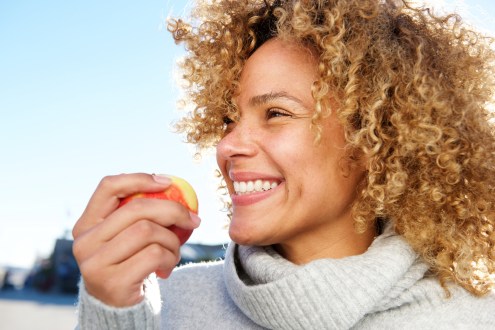The spectrum diet
Fruits and vegetables provide us with vitamins and minerals, but it’s their bright colours that could be the key to a healthy diet, says nutritionist Fiona Kirk

If I told you that eating one apple, one onion, one orange, a handful of spinach, a grilled tomato, a small green salad, a few florets of broccoli and a bowl of mixed berries every day would help you live to a healthy 100 years old, avoiding cancer, heart disease and a host of degenerative diseases along the way, would you believe me? And, more importantly, would you do it? A diet that is rich in fruits and vegetables is our best bet for preventing virtually every chronic disease. This has been endorsed by UK and US government health agencies, the World Health Organisation and almost every major medical organisation.
We’re all familiar with the government’s five-a-day campaign, yet data from the latest National Diet And Nutrition Survey show that in Great Britain, just 13 per cent of adult men and 15 per cent of adult women consume the daily recommended five or more portions.
Fruits and vegetables are so important to our health that some experts even believe some cancers may be the result of a ‘maladaptation’ over time to a reduced intake. A study published in the medical journal Cancer Causes & Control claimed ‘vegetables and fruit contain the anti-carcinogenic cocktail to which we are adapted. We abandon it at our peril.’
But scaring us into eating more fruits and vegetables isn’t working. We are either too busy, too stressed, too uninterested in our own health or too addicted to eating junk to take the message seriously — until it’s too late. It was originally thought that it was only the vitamin and mineral content of fruits and vegetables, and the fibre, that conferred extensive health benefits.
But now the focus is switching to phytochemicals, naturally occurring compounds that give fruits and vegetables their distinctive and varied bright colours. Phytochemicals are a plant’s protection. They are believed to have evolved in order to help plants adjust to changes in the earth’s atmosphere. When the earliest plants appeared on the planet, only a small amount of oxygen was present. Due to the metabolic processes of plants, which take in carbon dioxide and give out oxygen, the atmosphere began to change. Oxygen levels increased to such an extent that the environment became hostile to plants.
Over time, some plants developed a number of antioxidant compounds that protected them, and these better-equipped plants endured and evolved into the plants we are familiar with today. They also developed biochemical means of protecting themselves from other environmental hazards such as viruses and fungi.
And when we eat these plants, they may offer us some protection, too. But why is colour so important? Many of these phytochemical compounds are concentrated in the external tissues (skin and peel) and their bright colours attract insects and birds for pollination and seed dispersal (vital for continuation of the species). They are also concentrated in the core of the plant (in the pips and seeds) to protect its precious genetic material.
Often peel and pips are discarded resulting in a vastly reduced dose of phytochemicals, antioxidants and fibre.
So, when possible, wash or scrub your fruits and vegetables and enjoy them fresh and raw, or lightly cooked. Phytochemicals are divided into groups depending on their chemical structure. Each has a different arrangement of carbon atoms that allows it to absorb and/or reflect wavelengths from light, giving it its distinctive colour.
And it is becoming clear that the broader the range of colours we eat, the greater the health benefits. While certain fruits and vegetables have been touted as ‘superfoods’, there is no single food that is going to bring about ‘super’ health. The body needs a balance of macro nutrients in the form of carbohydrates, proteins and fats; micro nutrients in the form of vitamins and minerals; and accessory nutrients in the form of phytochemicals in order to energise, repair and regenerate. Variety is the key. Pack as many colours into your diet as you can. Think of them as a health-enhancing injection of colour into your life.
How to get the most out of your fruit and veg
• Make sure your shopping basket is full of colour.
• Juice a couple of fruits every day — it takes minutes.
• Steam a bag of mixed vegetables, drizzle with olive oil and lemon juice and eat while you are preparing supper.
• Fill at least half your plate with salad or vegetables. The rest of your plate should be filled with protein, and grains or carbs.
• Keep a bag of fruit or raw baby vegetables in your handbag or desk drawer to snack on.
• Keep a fruit bowl where you can see it and regularly refill.
• Make a pot of soup using as many different veg as possible.
• Experiment with cooking methods — steam, grill, bake, roast, kebab, purée.
• There are seven days in every week. Go for a different colour every day for a week and chart how many ways you can get that colour into your diet. Experiment with fruits and vegetables you are unfamiliar with.
Fiona Kirk is the author of So What The F*** Should I Eat?








